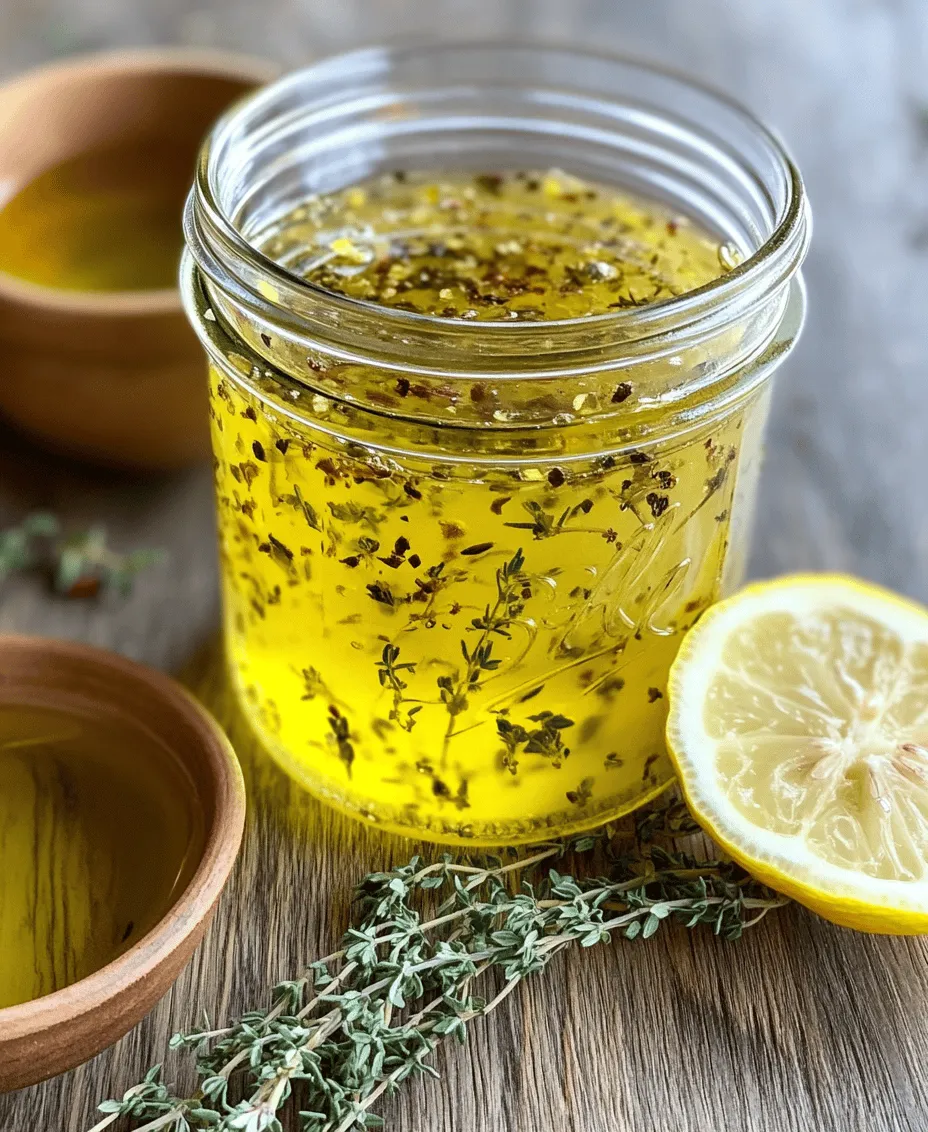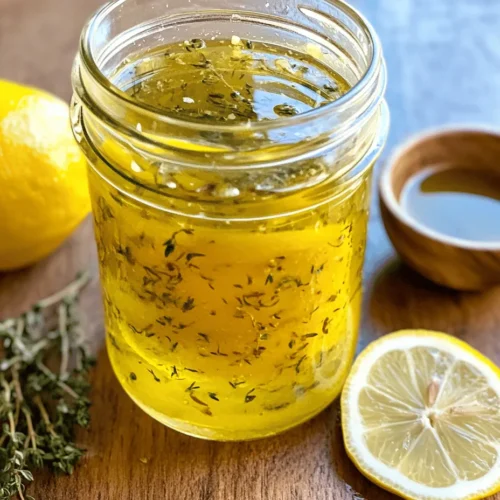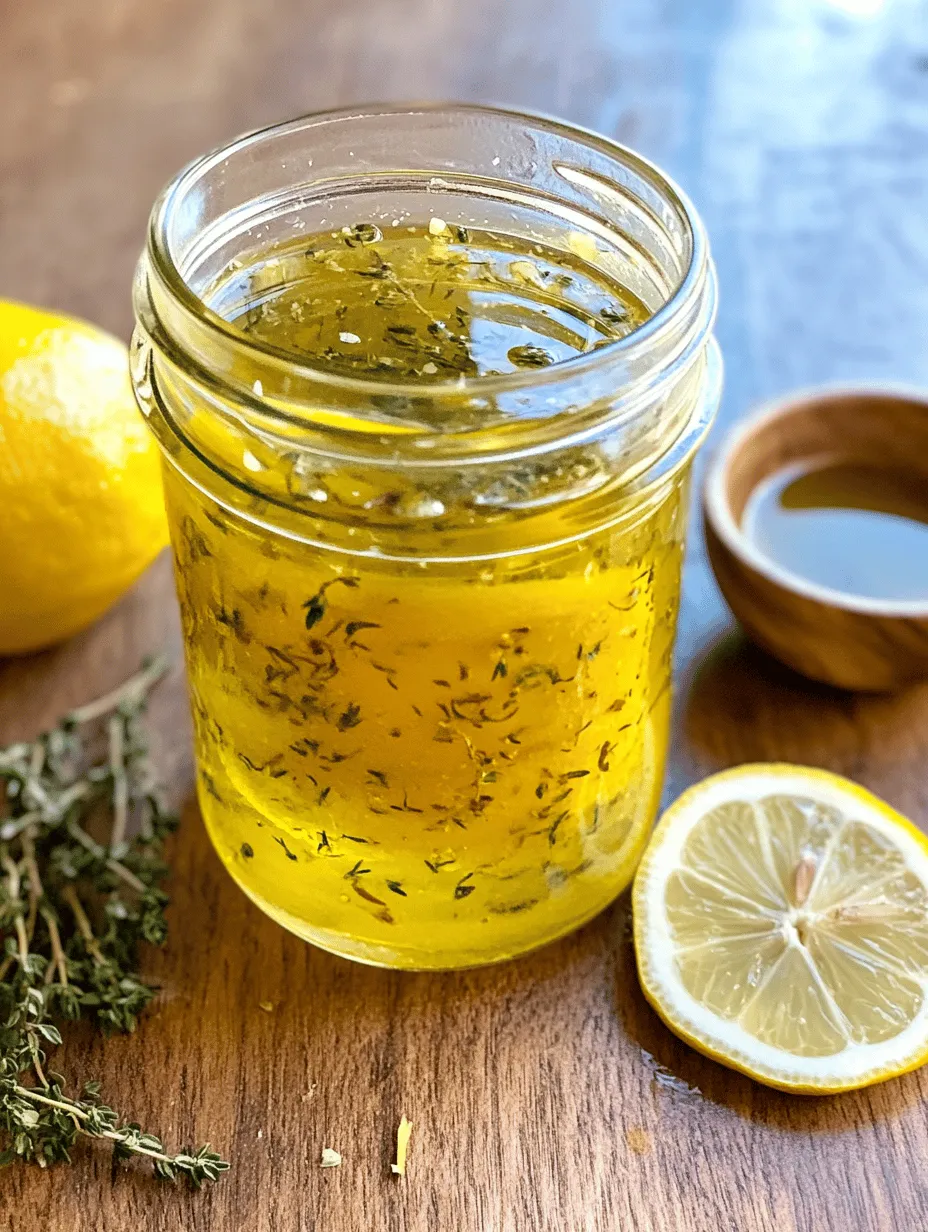Introduction to Zesty Lemon Vinaigrette Dressing
Dressings are not merely toppings; they are essential components that elevate the flavor profile of dishes. Whether drizzled over a fresh salad, used as a marinade for proteins, or served as a dipping sauce, the right dressing can transform a mundane meal into a culinary masterpiece. Among the myriad of dressing options, zesty lemon vinaigrette stands out for its bright, refreshing flavor and versatility. This vinaigrette is a staple in kitchens worldwide, cherished for its ability to enhance flavors without overpowering them.
Crafted from simple, wholesome ingredients, zesty lemon vinaigrette is not only delicious but also offers numerous health benefits. Fresh lemon juice provides a burst of vitamin C, while extra virgin olive oil delivers healthy fats that can support heart health. Together, these ingredients create a dressing that is both delightful and nutritious. Whether you’re dressing a garden salad or incorporating it into a grain bowl, this zesty vinaigrette adds brightness and zest that can enliven any dish.
Understanding the Ingredients of Zesty Lemon Vinaigrette
The ingredients in zesty lemon vinaigrette are what make it shine. Each component not only contributes a unique flavor but also offers health benefits that enhance your overall well-being. Below, we delve into the specific ingredients that comprise this vibrant dressing.
Fresh Lemon Juice: The Heart of the Dressing
Fresh lemon juice is the star of this zesty vinaigrette, providing a bright and tangy flavor that is both refreshing and invigorating. Rich in vitamin C, lemons are known for their immune-boosting properties, making this dressing a health-conscious choice. The acidity of lemon juice plays a crucial role in balancing flavors, cutting through richness, and brightening up dishes.
In addition to enhancing taste, the acidity in lemon juice can help to tenderize proteins when used as a marinade, making it a valuable component in various culinary applications.
Extra Virgin Olive Oil: Quality Matters
When it comes to making a vinaigrette, the quality of the olive oil you choose can significantly affect the final product. Extra virgin olive oil is the best choice, as it is cold-pressed and retains more of the natural flavors and nutrients found in olives. This high-quality oil not only adds a smooth and rich texture to the dressing but also contributes beneficial monounsaturated fats that can promote heart health.
Olive oil is known for its anti-inflammatory properties and is rich in antioxidants, making it a healthy fat choice for any diet. The creamy texture of extra virgin olive oil blends beautifully with lemon juice, creating an emulsified dressing that clings perfectly to your salad greens or roasted vegetables.
Dijon Mustard: The Secret Ingredient
Dijon mustard may not be the first ingredient that comes to mind when thinking about vinaigrette, but it plays a crucial role in this recipe. Known for its sharp, tangy flavor, Dijon mustard enhances the overall taste of the dressing while also acting as an emulsifier. This means it helps to combine the oil and vinegar or lemon juice, preventing them from separating and ensuring a smooth, cohesive dressing.
Additionally, Dijon mustard contains beneficial nutrients like selenium and omega-3 fatty acids, adding another layer of health benefits to your vinaigrette.
Honey or Maple Syrup: Sweetness with a Purpose
To balance the acidity of the lemon juice, a touch of sweetness is often necessary. Honey is a classic addition to vinaigrettes, providing a natural sweetness that complements the tangy flavors. However, for those following a vegan diet, maple syrup serves as an excellent alternative, offering a similar sweetness without any animal products.
The inclusion of honey or maple syrup not only enhances the overall flavor profile but also rounds out the acidity, creating a harmonious balance that makes the vinaigrette pleasing to the palate.
Garlic: An Aromatic Boost
Garlic is another ingredient that adds depth and complexity to zesty lemon vinaigrette. Its pungent flavor can elevate the dressing, imparting an aromatic quality that pairs beautifully with the bright citrus notes. Garlic is also packed with health benefits, known for its anti-inflammatory and immune-boosting properties.
When used in moderation, garlic enhances the flavor without overwhelming it, making it an essential ingredient for those who enjoy a little extra zing in their vinaigrette.
Fresh Thyme Leaves: An Optional Herbal Note
While not mandatory, adding fresh thyme leaves can introduce a delightful herbal note to your zesty lemon vinaigrette. Fresh herbs are known for their health benefits, including antioxidants and anti-inflammatory properties. Thyme, in particular, complements the bright flavors of lemon beautifully, creating a well-rounded dressing that is both aromatic and flavorful.
Incorporating fresh thyme can elevate your vinaigrette to the next level, making it a standout addition to your meals.
Lemon Zest: The Finishing Touch
To intensify the lemon flavor in your vinaigrette, don’t forget to add lemon zest. The zest, which is the outermost peel of the lemon, contains essential oils that are bursting with flavor. Including lemon zest not only enhances the citrus notes but also adds a vibrant aroma that can make the dressing even more appealing.
Using lemon zest is a simple way to amplify the intensity of your vinaigrette, ensuring that every bite is packed with zesty goodness.
Step-by-Step Guide to Making Zesty Lemon Vinaigrette
Now that we’ve explored the key ingredients of zesty lemon vinaigrette, it’s time to prepare this delightful dressing. Following a step-by-step guide will help you achieve the perfect balance of flavor and texture, ensuring that your vinaigrette is a hit every time.
1. Gather Your Ingredients: Start by collecting all the ingredients you’ll need for your vinaigrette. This includes fresh lemon juice, extra virgin olive oil, Dijon mustard, honey or maple syrup, garlic, fresh thyme (if using), and lemon zest.
2. Prepare the Lemon Juice: Squeeze fresh lemons to extract the juice. Depending on the size of your lemons, you may need two to three lemons to yield about 1/4 cup of juice. Strain the juice to remove any seeds and pulp for a smoother dressing.
3. Measure the Olive Oil: For every part of lemon juice, you’ll want to use about three parts of olive oil. If you’re using 1/4 cup of lemon juice, prepare to use about 3/4 cup of extra virgin olive oil.
4. Combine the Ingredients: In a mixing bowl or a jar with a lid, combine the freshly squeezed lemon juice, Dijon mustard, honey or maple syrup, and minced garlic. Whisk or shake the mixture together until it is well combined.
5. Slowly Add Olive Oil: While whisking continuously, slowly drizzle in the extra virgin olive oil. This gradual incorporation is crucial for creating an emulsified dressing that won’t separate.
6. Taste and Adjust: After adding all the olive oil, taste the vinaigrette and adjust the seasoning as needed. You may want to add more lemon juice for acidity, honey or maple syrup for sweetness, or additional salt and pepper to enhance the flavors.
7. Finish with Zest and Thyme: If you’re using fresh thyme, finely chop the leaves and stir them into the vinaigrette. Finally, add the lemon zest for an extra punch of flavor.
8. Store or Serve: Your zesty lemon vinaigrette is now ready to use! If you’re not using it immediately, store it in an airtight container in the refrigerator for up to one week. Shake well before serving, as the ingredients may separate over time.
By following these steps, you’ll create a zesty lemon vinaigrette that not only enhances your salads but also adds a refreshing touch to grilled vegetables, fish, or even as a marinade for meats. Enjoy the bright, tangy flavors and the health benefits that come with this delightful dressing!

Juicing the Lemons: Techniques for Maximum Juice Extraction
When it comes to making a zesty lemon vinaigrette, the quality and quantity of lemon juice you extract are crucial. Here are some effective techniques to ensure you get the most juice from your lemons:
1. Choose Room Temperature Lemons: If possible, let your lemons sit at room temperature for a while before juicing. Warmer lemons yield more juice compared to cold ones straight from the fridge.
2. Roll and Press: Before cutting, roll each lemon firmly on the countertop with the palm of your hand. This action helps to break down the internal membranes, making it easier to extract juice.
3. Use a Juicer: A handheld juicer or citrus press can make the job easier. Simply cut the lemon in half, place it cut-side down in the juicer, and press to extract the juice.
4. Strain for Seeds: Always strain the juice to remove any seeds or pulp if you prefer a smoother vinaigrette. This can be done using a fine mesh strainer.
Tips on Selecting the Best Lemons
The flavor of your vinaigrette largely depends on the quality of your lemons. Here’s how to choose the best ones:
– Look for Bright Yellow Color: Choose lemons that are vibrant in color. Dull or greenish lemons may not be ripe and can have a bitter taste.
– Check for Firmness: Gently squeeze the lemons; they should feel firm yet have a slight give. Overly soft lemons may be past their prime.
– Smell the Lemons: Fresh lemons should have a fragrant citrus aroma. If they lack scent, they may not be as flavorful.
Combining Ingredients: Achieving the Perfect Balance
Once you’ve juiced your lemons, it’s time to combine the ingredients. The key to a fantastic vinaigrette lies in balancing the flavors of the lemon juice, olive oil, and seasonings.
– Start with the Acid: In a bowl, whisk together the fresh lemon juice with any other acids you might be adding, such as vinegar. This will help to balance the flavors right from the start.
– Slowly Add Oil: Gradually whisk in high-quality extra virgin olive oil. A good rule of thumb is to use a 1:3 ratio of acid to oil. Adjust this ratio based on your taste preferences.
Importance of Whisking and Proper Technique
Whisking is not just about mixing; it plays a vital role in creating a stable vinaigrette. Here’s why proper technique matters:
– Incorporating Air: Whisking adds air to the mixture, which helps emulsify the ingredients. This process creates a light and airy vinaigrette.
– Preventing Separation: A good whisking technique helps to keep the vinegar and oil from separating. It ensures that every bite has a consistent flavor.
Emulsifying the Dressing: Creating a Smooth Consistency
Emulsification is the process of mixing two liquids that typically don’t combine, like oil and vinegar. Here’s how to achieve that smooth consistency in your vinaigrette:
1. Start Slowly: When adding the oil, do it gradually while whisking vigorously. This helps to break down the oil into tiny droplets that mix with the vinegar or lemon juice.
2. Use a Blender: For an even smoother texture, consider blending your vinaigrette in a food processor or with an immersion blender. This method will ensure a consistent emulsification.
Explanation of Emulsification in Vinaigrettes
Emulsification is crucial in vinaigrettes because it allows for a uniform mixture that clings to salad leaves and other ingredients. Without proper emulsification, the oil and vinegar will quickly separate, causing a lack of flavor in your dish. A well-emulsified vinaigrette not only enhances the taste but also improves the mouthfeel, providing a more enjoyable dining experience.
Seasoning the Vinaigrette: Personalizing Flavors
Once your vinaigrette is emulsified, it’s time to season it to elevate the flavor profile. Here are some tips on personalizing your vinaigrette:
– Salt and Pepper: Start with kosher salt and freshly ground black pepper. Taste as you go to find the right balance.
– Add Herbs and Spices: Fresh herbs like basil, parsley, or dill can add a delightful freshness. You may also consider spices like garlic powder, onion powder, or even a pinch of cayenne for heat.
– Sweeten if Needed: If the vinaigrette is too tart for your liking, a teaspoon of honey, maple syrup, or agave nectar can help balance the acidity.
How to Taste and Adjust for Personal Preferences
Creating the perfect vinaigrette is about adjusting to your personal taste. Here’s how to ensure it’s just right:
– Taste Regularly: After each addition, taste the vinaigrette. This will help you understand how different ingredients affect the flavor.
– Adjust Gradually: Make small adjustments. If it’s too acidic, add more oil. If it’s too oily, add a splash more lemon juice or vinegar.
– Consider the Dish: Keep in mind what you’ll be serving the vinaigrette with. If it’s for a rich salad, you might want a more acidic dressing to balance the flavors.
Storing and Using the Vinaigrette: Best Practices
Proper storage of your homemade vinaigrette is essential to maintain its flavor and freshness. Here are some best practices:
– Use a Clean Jar: Store your vinaigrette in a clean, airtight container. A glass jar with a tight-fitting lid works well.
– Refrigerate: Store the vinaigrette in the refrigerator, where it can last for up to two weeks.
– Shake Before Use: Since homemade vinaigrettes can separate over time, give the jar a good shake before each use to re-emulsify the mixture.
Versatility of Zesty Lemon Vinaigrette
One of the best aspects of homemade zesty lemon vinaigrette is its versatility. Here are some creative ways to use it beyond just a salad dressing:
– Salad Dressings: Drizzle it over mixed greens, grain-based salads, or even as a dressing for coleslaw.
– Marinades: Use the vinaigrette as a marinade for chicken, shrimp, or tofu. The acidity from the lemon juice tenderizes the proteins while infusing flavor.
– Roasted Vegetables: Toss your favorite vegetables in the vinaigrette before roasting them. It adds a zesty flavor that enhances their natural sweetness.
– Grain Bowls and Pasta: Use the vinaigrette as a dressing for grain bowls or pasta salads. It complements the ingredients while adding a refreshing zest.
Health Benefits of Homemade Vinaigrette
Creating your vinaigrette at home not only elevates your culinary creations but also offers numerous health benefits:
– Comparison to Store-Bought Dressings: Store-bought dressings often contain preservatives, additives, and unhealthy fats. By making your vinaigrette, you control what goes in, ensuring it’s fresher and healthier.
– Control Over Ingredients and Flavors: You can customize your vinaigrette to suit dietary needs, such as gluten-free, vegan, or low-sodium options.
– Avoiding Preservatives and Artificial Ingredients: Homemade vinaigrette is free from artificial flavors and preservatives, making it a healthier choice for you and your family.
– Nutritional Benefits: The key ingredients in your vinaigrette—olive oil, lemon juice, and herbs—offer health benefits such as antioxidants, heart-healthy fats, and vitamins.
Conclusion: The Joy of Homemade Zesty Lemon Vinaigrette
Homemade zesty lemon vinaigrette is a simple yet versatile dressing that can elevate any dish. With just a few fresh ingredients, you can create a dressing that enhances the flavor of salads, marinades, roasted vegetables, and more. The satisfaction of crafting your vinaigrette not only allows for experimentation but also guarantees a healthier option compared to store-bought alternatives.
So, gather your lemons, embrace your creativity, and enjoy the delightful experience of making your own zesty lemon vinaigrette. The possibilities are endless, and the joy of homemade dressing is unmatched. Whether you keep it simple or try new flavor combinations, your culinary adventures with this vinaigrette will surely be rewarding.



